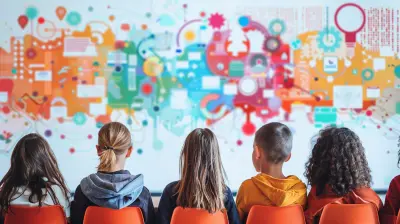The Importance of Social-Emotional Learning in Health Education
22 October 2025
In today's fast-paced world, education is no longer just about mastering academics. It’s not just about memorizing facts or acing exams anymore (although those things are important too). Schools are now realizing that fostering emotional intelligence and social skills in students is just as crucial as teaching them math and science. This is where Social-Emotional Learning (SEL) steps in, especially in the context of health education.
But what exactly is Social-Emotional Learning, and why is it such a game-changer in health education? Let’s unpack it, shall we?

What is Social-Emotional Learning (SEL)?
Social-Emotional Learning (SEL) is a framework designed to help individuals—especially students—develop essential social and emotional skills. These skills range from understanding and managing emotions, setting positive goals, showing empathy towards others, establishing and maintaining healthy relationships, and making responsible decisions. It’s about nurturing the "whole" person, not just the academic side.Think of SEL as the emotional toolkit students need to navigate the ups and downs of life. It teaches them how to handle stress, resolve conflicts, and collaborate with others. In the grand scheme of things, SEL equips students to become well-rounded individuals who are not only smart but also emotionally resilient.

Why is SEL Important in Health Education?
Now, you might be wondering, "What does SEL have to do with health education?" The answer is everything! Health education isn't just about physical well-being; it also encompasses mental and emotional health. And let’s face it, mental health is just as important as physical health—maybe even more so in some instances.Here’s why SEL is vital in health education:
1. Promotes Emotional Well-being
Health education often covers topics like nutrition, exercise, and personal hygiene, but what about mental health? Students face a range of emotional challenges, from stress to anxiety, and sometimes even depression. SEL helps students recognize and understand their emotions, and more importantly, teaches them how to cope in healthy ways.For example, stress is inevitable in life, but SEL helps students develop coping strategies such as mindfulness, positive self-talk, or even reaching out to others for support. It’s like giving them the emotional tools to handle life’s curveballs.
2. Better Decision-Making
Health education encourages students to make informed decisions about their bodies—whether it’s choosing what to eat, how to exercise, or understanding the risks of substance abuse. SEL enhances this by teaching them how to think critically, weigh the pros and cons, and make responsible decisions.You know that voice in your head that says, "Maybe I shouldn’t eat that entire pizza by myself"? That’s SEL in action. It’s about helping students develop self-discipline and think about the long-term consequences of their actions, whether it's about food, peer pressure, or even relationships.
3. Fosters Healthy Relationships
Let's be honest—relationships can be tricky. Health education often touches on the importance of good communication, understanding consent, and building respectful relationships. SEL takes it a step further by teaching students how to empathize with others, manage conflicts, and build strong, meaningful connections.With SEL, students learn the importance of setting boundaries and respecting those of others. Whether it's in friendships, romantic relationships, or professional settings, understanding how to interact with others in a healthy way is key to overall well-being. SEL helps students grasp these social dynamics early on.
4. Prepares Students for Life Beyond the Classroom
At the end of the day, education is preparing students for the real world. And let’s be real—life isn’t just about how well you can solve algebra equations or write essays. It’s about how well you manage stress, how you bounce back from failure, and how you interact with the people around you.SEL in health education ensures that students are emotionally and socially equipped for life outside the classroom. Whether it’s in the workplace, at home, or in their communities, SEL gives students the confidence and emotional intelligence to thrive in any environment.

The Science Behind SEL: Why It Works
You might be thinking, "Okay, SEL sounds great, but does it actually work?" The answer is a resounding yes. There’s a mountain of research that supports the benefits of Social-Emotional Learning, particularly in school settings.SEL and Academic Performance
According to a landmark study by the Collaborative for Academic, Social, and Emotional Learning (CASEL), students who participated in SEL programs showed an average of 11% improvement in academic performance. Why? Because students who can regulate their emotions are better at focusing in class, managing stress during tests, and collaborating on group projects.SEL and Mental Health
Another significant benefit of SEL is its impact on mental health. Research shows that SEL can reduce symptoms of depression and anxiety in students. In fact, a study published in the American Journal of Public Health found that students who received SEL education were less likely to experience mental health issues later in life.SEL and Behavior
Students who participate in SEL programs also tend to exhibit fewer behavioral problems. They are less likely to engage in bullying, substance abuse, or violence. Why? Because SEL teaches them how to manage their emotions, empathize with others, and resolve conflicts peacefully.SEL and Long-Term Outcomes
The benefits of SEL don’t stop at graduation. Long-term studies have shown that individuals who received SEL instruction in school are more likely to have successful careers, healthy relationships, and a greater sense of overall well-being as adults. So, in a sense, SEL is the gift that keeps on giving.
How Can Schools Incorporate SEL into Health Education?
Now that we know how important SEL is, how can schools make sure it’s integrated into health education?1. Embed SEL into the Health Curriculum
One of the simplest ways is by embedding SEL directly into the health curriculum. Lessons on stress management, emotional regulation, or healthy relationships are perfect opportunities to incorporate SEL principles. For example, a health class on nutrition could also include a discussion on how emotions affect eating habits—aka emotional eating.2. Create a Supportive Learning Environment
SEL thrives in a supportive, inclusive environment. Teachers should foster classrooms that encourage open discussions, where students feel safe to express their emotions and opinions. Implementing "circle time" or "check-ins" at the start of a health class can help students share their feelings and reflect on their emotional well-being.3. Utilize Interactive Activities
SEL isn’t just about lectures; it’s about practice. Schools can incorporate role-playing exercises, group discussions, or mindfulness activities that allow students to practice empathy, emotional regulation, and conflict resolution in a hands-on way. This makes SEL feel less abstract and more tangible.4. Involve Parents and the Community
SEL doesn’t stop when the school bell rings. It’s essential to involve parents and the community in the process. Schools can host workshops or provide resources so that families can reinforce SEL principles at home. After all, learning emotional intelligence is a lifelong journey.Challenges to Implementing SEL in Schools
While the benefits of SEL are clear, implementing it isn’t without challenges. Some schools may face budget constraints, a lack of trained staff, or even resistance from parents or policymakers who may not fully understand the value of SEL.However, the long-term benefits far outweigh the initial hurdles. Schools that invest in SEL are investing in the future well-being and success of their students.
Final Thoughts: SEL is the Future of Health Education
Social-Emotional Learning isn’t just a "nice-to-have" anymore—it’s a "must-have," especially in health education. As we continue to prioritize mental health and emotional well-being, SEL provides students with the tools they need to lead happier, healthier, and more successful lives.It’s time we stop treating emotions as an afterthought and start integrating them into our education systems. After all, emotional intelligence is just as important as any other subject, and when combined with health education, it creates a powerful recipe for lifelong well-being.
all images in this post were generated using AI tools
Category:
Health EducationAuthor:

Zoe McKay
Discussion
rate this article
1 comments
Alexander Vance
Thank you for highlighting the crucial link between social-emotional learning and health education. Fostering emotional well-being not only empowers students academically, but also equips them with essential life skills for a healthier, more resilient future.
October 31, 2025 at 3:43 AM

Zoe McKay
Thank you for your insightful comment! I'm glad you recognize the vital connection between social-emotional learning and health education.


